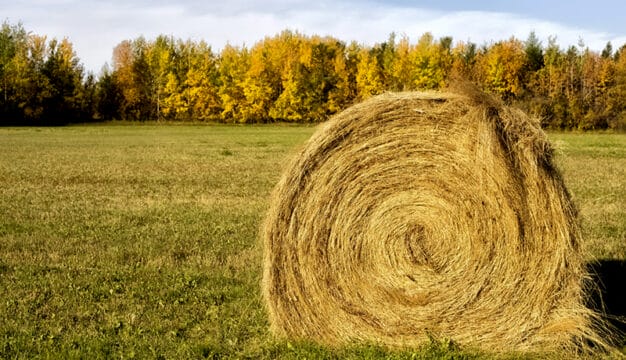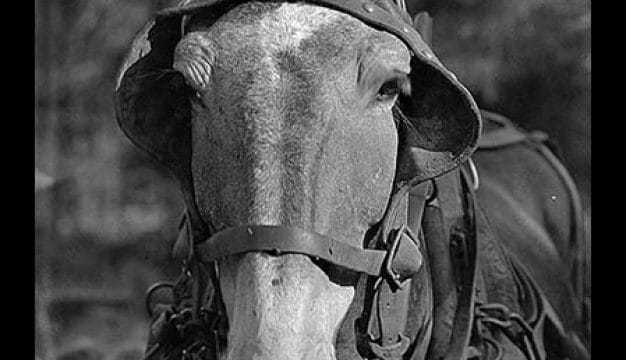Fly Fishing in Alabama
 Fly Fishing in Alabama
Although fly fishing is often associated with the trout streams of the northeastern and western states, many Alabama anglers use the fly rod to pursue various species of fish in the state’s numerous water sources. When fly fishing, the angler casts a weighted line and a virtually weightless lure, rather than the heavy lure or bait on thin line used in other types of fishing. The lure, or artificial bait, is called a fly regardless of whether it actually looks like an insect or some other type of forage for the targeted fish. Because the weight is in the line (rather than in the lure or sinker), the fly fisher can throw lures of any size and weight by varying the mass of the line. This offers a versatility in lures and tactics not available with other methods.
Fly Fishing in Alabama
Although fly fishing is often associated with the trout streams of the northeastern and western states, many Alabama anglers use the fly rod to pursue various species of fish in the state’s numerous water sources. When fly fishing, the angler casts a weighted line and a virtually weightless lure, rather than the heavy lure or bait on thin line used in other types of fishing. The lure, or artificial bait, is called a fly regardless of whether it actually looks like an insect or some other type of forage for the targeted fish. Because the weight is in the line (rather than in the lure or sinker), the fly fisher can throw lures of any size and weight by varying the mass of the line. This offers a versatility in lures and tactics not available with other methods.
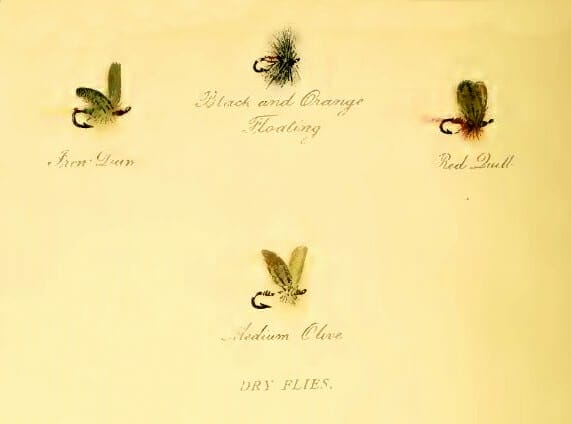 Trout Flies
Fly fishing is the oldest form of fishing with artificial bait. The activity is mentioned in numerous ancient texts, including a second-century text by Roman author and teacher Aelian, who described Macedonian fishermen using “wool . . . and . . . feathers . . . on a hook” as lures for trout. Revolving spool reels were added in the late nineteenth century, and the spinning reel was introduced in 1949. Prior to these inventions, however, fly fishing was the standard method of casting artificial baits. The first artificial lures for bass in the United States were thrown with a fly rod, and it is still a very effective means of fishing for most species.
Trout Flies
Fly fishing is the oldest form of fishing with artificial bait. The activity is mentioned in numerous ancient texts, including a second-century text by Roman author and teacher Aelian, who described Macedonian fishermen using “wool . . . and . . . feathers . . . on a hook” as lures for trout. Revolving spool reels were added in the late nineteenth century, and the spinning reel was introduced in 1949. Prior to these inventions, however, fly fishing was the standard method of casting artificial baits. The first artificial lures for bass in the United States were thrown with a fly rod, and it is still a very effective means of fishing for most species.
In the past, most Alabama fly anglers typically fished small local ponds, casting little floating bugs under overhanging willow limbs to catch bluegill or other varieties of sunfish (known as bream in the South) or sometimes largemouth bass (the official state fish). Today, state-owned fishing lakes and larger hydroelectric reservoirs in almost every part of the state offer plentiful fly fishing for these species.
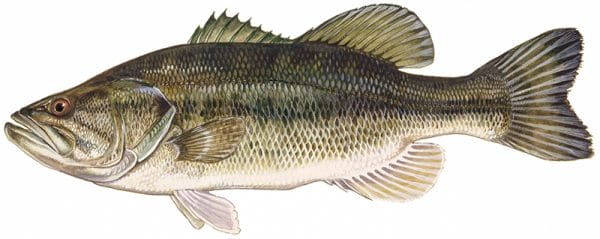 Largemouth Bass
In addition to the largemouth bass, other members of the black bass family provide great fly-fishing opportunities in Alabama. The state is home to two subspecies of the spotted bass: one that lives in the upper Mobile basin and another northern subspecies that inhabits the rest of the state. The “spot” is a hard-fighting game fish that thrives in large reservoirs, rivers, and streams. The smallmouth bass is native to the streams in the Tennessee River basin in northern Alabama. The area below Joe Wheeler Dam, in Lauderdale County, is one of the top-rated smallmouth fisheries, and several world-record fish have come from those waters. Other locations for smallmouth fishing include small streams that are suitable for wade fishing or floating in small boats or canoes, which is perfect for fishing with a fly rod. The redeye bass and the shoal bass, both native to the state, are somewhat rare, with the shoal bass limited in Alabama to the Chattahoochee River watershed. The redeye is somewhat more widespread in streams above the fall line, but both do best in long, free-flowing sections of river.
Largemouth Bass
In addition to the largemouth bass, other members of the black bass family provide great fly-fishing opportunities in Alabama. The state is home to two subspecies of the spotted bass: one that lives in the upper Mobile basin and another northern subspecies that inhabits the rest of the state. The “spot” is a hard-fighting game fish that thrives in large reservoirs, rivers, and streams. The smallmouth bass is native to the streams in the Tennessee River basin in northern Alabama. The area below Joe Wheeler Dam, in Lauderdale County, is one of the top-rated smallmouth fisheries, and several world-record fish have come from those waters. Other locations for smallmouth fishing include small streams that are suitable for wade fishing or floating in small boats or canoes, which is perfect for fishing with a fly rod. The redeye bass and the shoal bass, both native to the state, are somewhat rare, with the shoal bass limited in Alabama to the Chattahoochee River watershed. The redeye is somewhat more widespread in streams above the fall line, but both do best in long, free-flowing sections of river.
Tactics for the members of the black bass family vary according to location and season more than species. Floating flies that imitate either insects or feeding or struggling fish are often effective. These flies are made from natural feathers, fur, and hair and from synthetic fibers and buoyant foam or cork. Sinking flies are also used to imitate both baitfish and insects. In very deep water, bass may be pursued with sinking fly lines to reach the depths where the fish are feeding.
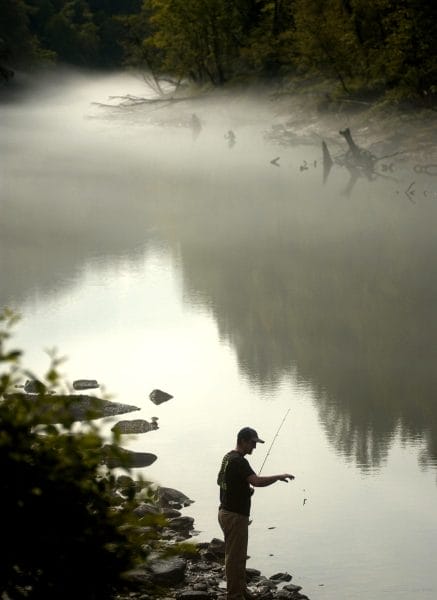 Fishing on Lewis Smith Lake
Trout fishing is available in limited locations in Alabama. The bulk of southeastern waters suitable for trout are located in the nearby Appalachian Mountains. However, the water below the Lewis Smith Dam on the Sipsey Fork of the Black Warrior River remains cold all year, and the state regularly stocks trout in the area. Trout are also stocked during the winter at Madison County State Public Fishing Lake. In addition, the Little River, in the northeast corner of the state, occasionally produces a trout courtesy of stockings in neighboring Georgia. Fly fishing is well-suited to trout fishing. Indeed, it is especially well-suited to imitating the actions of the small aquatic insects often preferred by trout.
Fishing on Lewis Smith Lake
Trout fishing is available in limited locations in Alabama. The bulk of southeastern waters suitable for trout are located in the nearby Appalachian Mountains. However, the water below the Lewis Smith Dam on the Sipsey Fork of the Black Warrior River remains cold all year, and the state regularly stocks trout in the area. Trout are also stocked during the winter at Madison County State Public Fishing Lake. In addition, the Little River, in the northeast corner of the state, occasionally produces a trout courtesy of stockings in neighboring Georgia. Fly fishing is well-suited to trout fishing. Indeed, it is especially well-suited to imitating the actions of the small aquatic insects often preferred by trout.
The striped bass is also becoming a popular quarry for Alabama fly anglers. A saltwater fish that spawns in freshwater, the “striper” has been stocked in many freshwater reservoirs and has adapted quite well to the environment. The striped bass is a favorite up and down the eastern Atlantic coast, but the Gulf Coast variety is less well known. In years past, before most of Alabama’s rivers were dammed, many of these striped bass migrated into the state’s waters to spawn in the spring. That spawning run today is very limited, but most Alabama river systems now have striped bass from state stocking efforts. The stripers can range up to 40 pounds and will eagerly take a fly imitating small baitfish. Heavier fly tackle, normally used for saltwater fishing, is preferred for these hard fighters.
In addition to the so-called “game fish,” some fly anglers enjoy pursuing some of the fish commonly referred to as “rough” fish, or nongame species. These fish include carp, gar, and bowfin, and all will take a fly and provide considerable sport for the nonpurist.
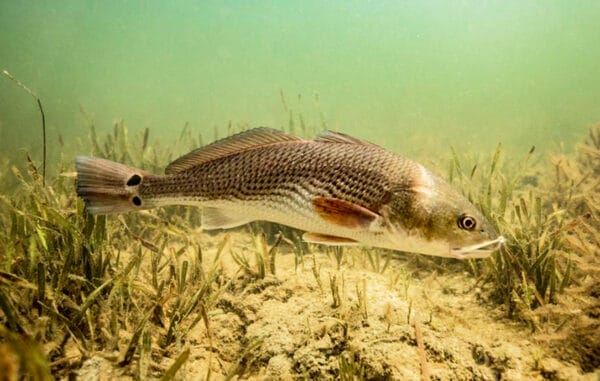 Redfish from the Gulf Coast
Perhaps the fastest growing segment of fly fishing is saltwater fishing. Many of the great game fish of the ocean are available to Alabama fly fishers. From sea trout and redfish to tarpon and sailfish, anglers today regularly catch them on the fly. Saltwater anglers often fish in shallow inshore areas, where some fish live and others move in to feed. The entire Alabama coast, from Mobile to Perdido Bay, offers inshore opportunities to the fly fisher. Even deep-water game, such as the billfish and the dorado (dolphinfish), readily take a fly. Saltwater anglers use flies that imitate shrimp, crabs, squid, and various baitfish.
Redfish from the Gulf Coast
Perhaps the fastest growing segment of fly fishing is saltwater fishing. Many of the great game fish of the ocean are available to Alabama fly fishers. From sea trout and redfish to tarpon and sailfish, anglers today regularly catch them on the fly. Saltwater anglers often fish in shallow inshore areas, where some fish live and others move in to feed. The entire Alabama coast, from Mobile to Perdido Bay, offers inshore opportunities to the fly fisher. Even deep-water game, such as the billfish and the dorado (dolphinfish), readily take a fly. Saltwater anglers use flies that imitate shrimp, crabs, squid, and various baitfish.
Although fly anglers make up a relatively small percentage of those who fish, their numbers continue to grow. Part of this growth is fueled by the trend of fly anglers to pursue not only trout and bass, but almost every species of game fish, in both fresh and saltwater. Alabama ranks second nationally in the number of native fish species that inhabit its waters. The future bodes well for fly fishing in the state. There has been a resurgence of interest in fly fishing as a result of major advances in equipment and the sharing of information via the internet and other media. Conservation and preservation efforts are increasing fish numbers and protecting habitat. Fly fishing, with its emphasis on sport rather than the harvest of fish, fits perfectly with modern ideals of a renewable resource.

